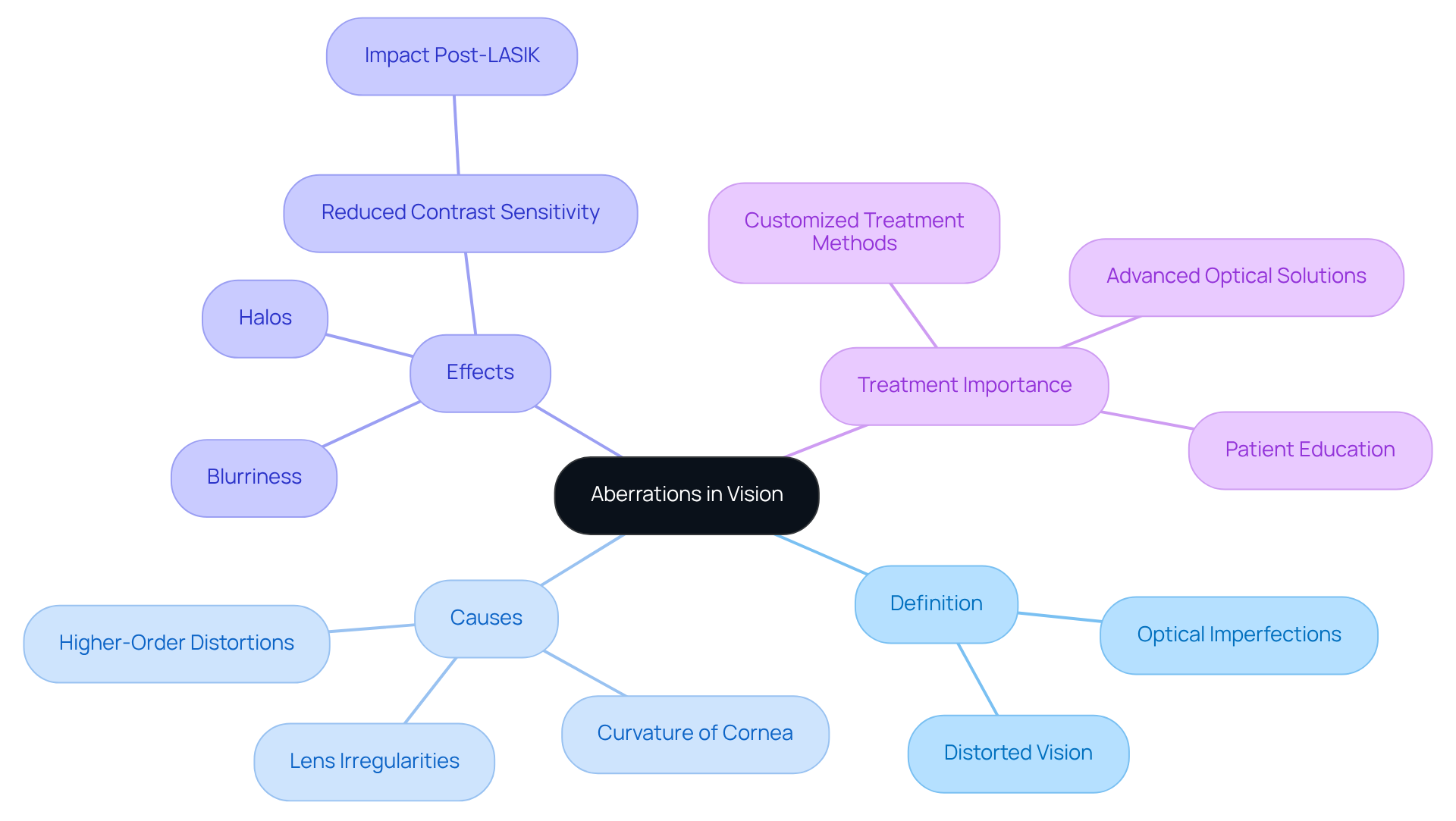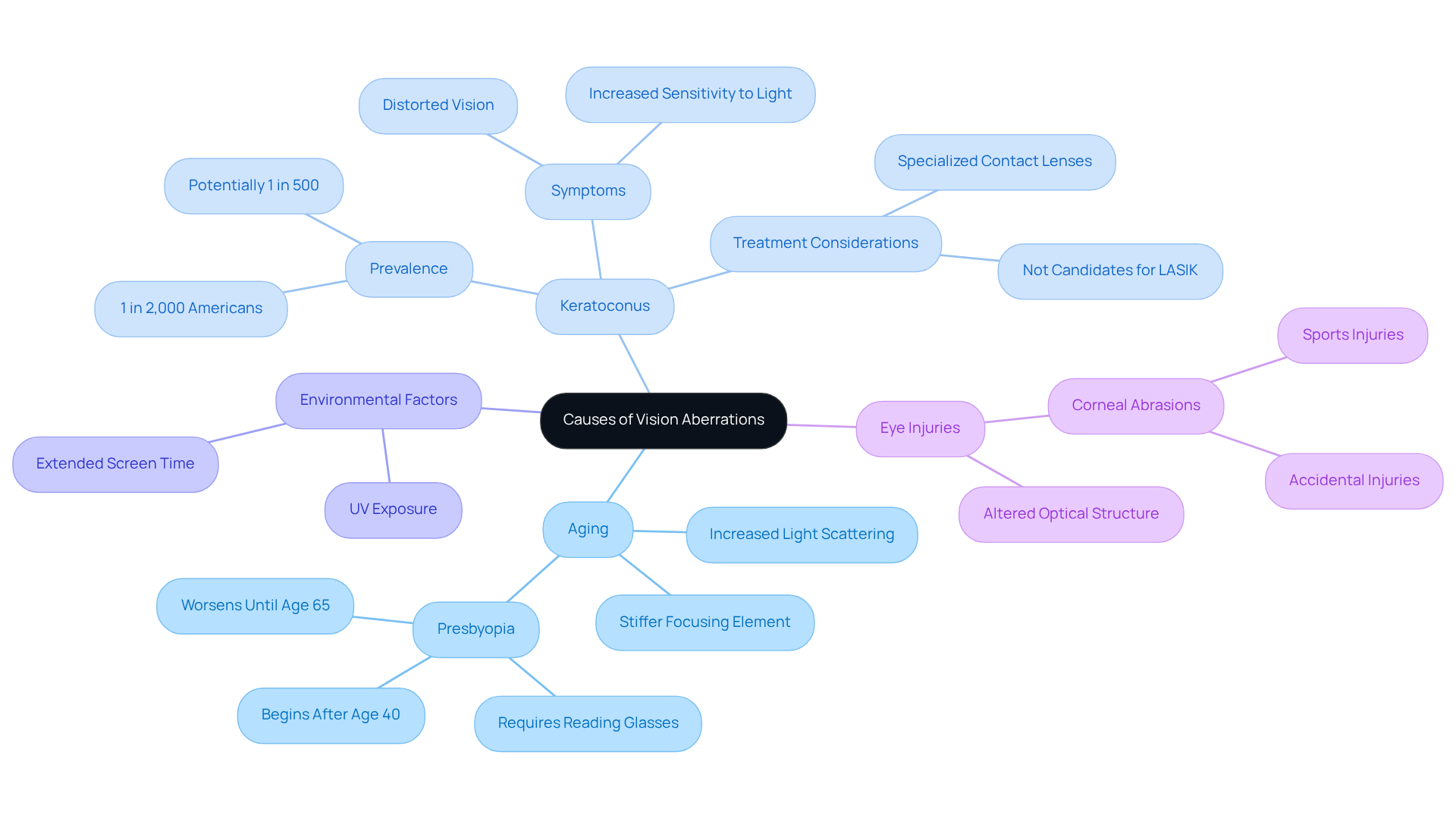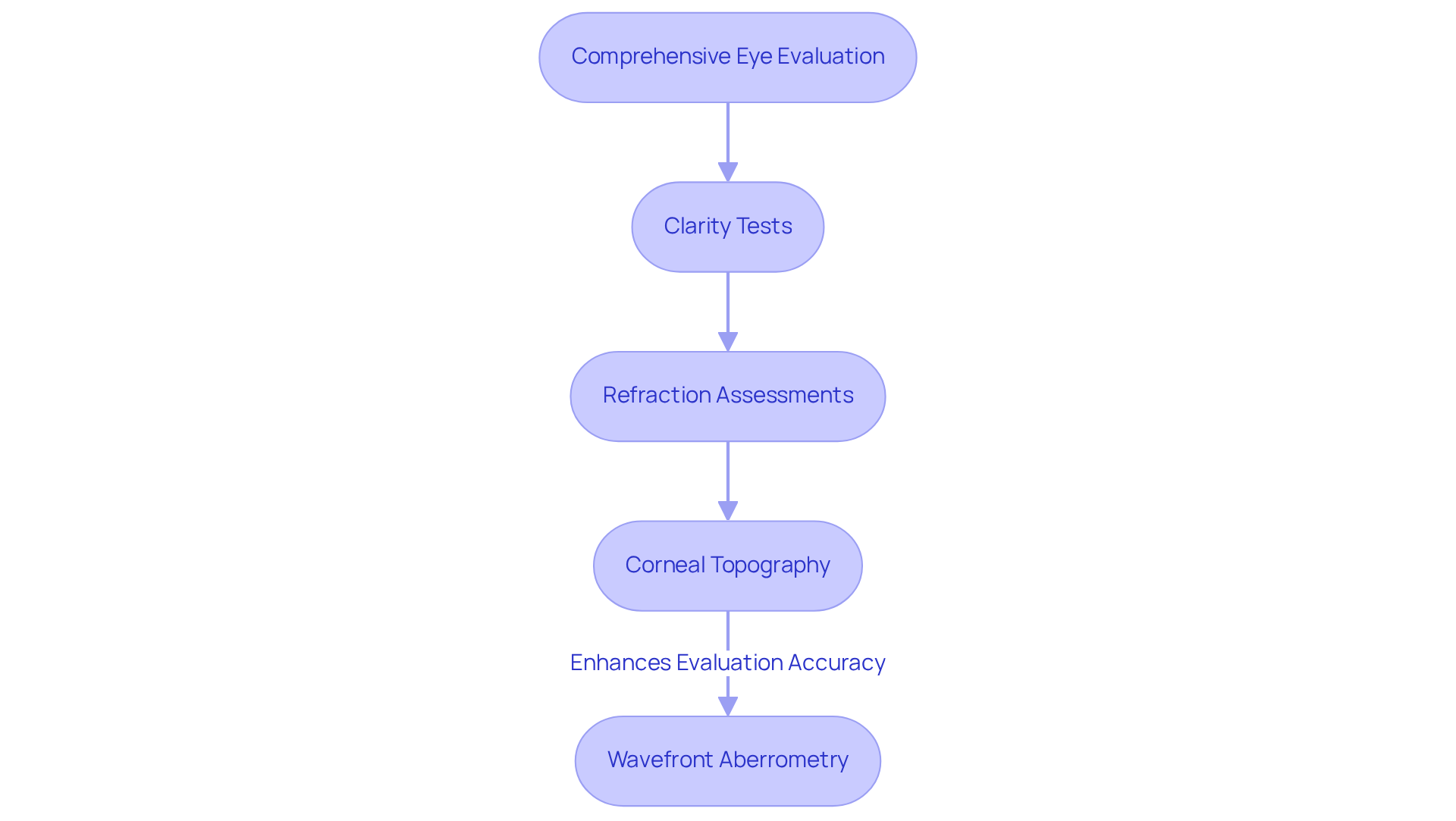Posted by: Northwest Eye in General on June 29, 2025
Overview
This article seeks to understand the challenges of vision aberrations, including their causes, symptoms, and the methods used for diagnosis. We recognize that issues like spherical distortion and astigmatism can significantly impact your visual clarity and overall quality of life. It’s common to feel concerned about how these conditions may affect you.
We want to reassure you that advanced diagnostic tools, such as wavefront aberrometry, play a crucial role in providing personalized treatment options. These tools help us understand your unique vision needs better, ensuring you receive the most effective care possible. Remember, you are not alone in this journey; we are here to help you through this process.
Introduction
Aberrations in vision, often overlooked, play a crucial role in how we perceive the world around us. These optical imperfections can lead to significant visual disturbances, such as blurriness and halos, which can affect daily activities and overall quality of life.
We understand that recognizing these issues can be daunting, yet understanding their causes and symptoms is essential. Many remain unaware of the implications these distortions can have on their lives.
What happens when these distortions go unrecognized?
How can you take proactive steps to improve your vision?
We are here to help you through this process.
Define Aberrations: Understanding Their Role in Vision
Aberrations are optical imperfections in the eye’s system that can significantly distort vision. We understand that these distortions can arise from various factors, including the curvature of the cornea and lens irregularities, leading to disturbances in sight such as blurriness, halos around lights, and reduced contrast sensitivity. For instance, studies indicate that up to 60% of patients may experience diminished contrast sensitivity following standard LASIK surgery, highlighting the prevalence of these issues.
Comprehending aberrations in optics is essential for acknowledging their effect on overall vision quality. It’s common to feel concerned about how these issues may impact your daily life. Studies indicate that higher-order distortions (HOAs) can result in considerable sight-related difficulties, affecting everyday tasks such as reading and driving. For example, patients with astigmatism frequently display increased levels of comatic distortions, which can significantly compromise image quality and depth of focus.
Real-world examples illustrate the importance of addressing these imperfections. Patients who have had cataract surgery with aspheric intraocular lenses (IOLs) have reported enhanced visual results, especially in dim lighting, due to the decreased internal spherical distortion linked to these lenses. This highlights the necessity of customized treatment methods based on individual variation profiles.
Ophthalmologists emphasize the importance of understanding these aberrations. As one specialist remarked, “Understanding the connection between distortions, depth of focus, image quality, and their interactions is crucial in optical designs intended to achieve significant values of depth of focus while preserving an acceptable standard of image quality.” This perspective strengthens the need for comprehensive eye care strategies that prioritize the correction of optical imperfections to improve sight performance and quality of life. We are here to help you through this process.

Explore Types of Aberrations: Common Variants and Their Effects
Irregularities in vision, such as spherical distortion, coma, and astigmatism, can significantly impact daily life and visual performance. We understand that these issues can be concerning. Spherical distortion occurs when light rays entering the eye at varying angles converge at different points, leading to a blurred image. This type of distortion accounts for roughly 50% of total higher-order distortions, affecting clarity and sharpness. The average root mean squared (RMS) deviation for the eye’s higher-order aberrations is 0.26 μm, highlighting the severity of these aberrations.
Coma, characterized by a comet-like distortion of images, is particularly pronounced in low-light conditions. We recognize that this can make tasks like night driving challenging due to glare and halos around lights. Astigmatism, a common refractive error, arises from an irregularly shaped cornea or eye structure, resulting in unclear vision and difficulties in activities that require sharp eyesight, like reading or using a computer.
Recent studies have shown that patients with myopia and astigmatism often experience increased discomfort and reduced contrast sensitivity, which can hinder their ability to perform daily activities effectively. For instance, one study found that after fitting contact lenses, both nearsighted and astigmatic patients reported notable enhancements in visual sharpness and low-contrast sensitivity. This highlights the importance of suitable corrective measures. Additionally, headaches and eye discomfort can result from aberrations, further affecting quality of life.
Understanding these aberrations is crucial for recognizing their impact on your quality of life. Eye care experts emphasize that while total correction of these flaws may not always be achievable, significant improvements in visual performance can be attained through personalized correction techniques, including specialized glasses and contact lens options. As one specialist observed, ‘The kind and design of contact eyewear can affect the patient’s quality of sight, as the eyewear alters the overall optical properties of the seeing system.’ Another expert noted, ‘Myopic and astigmatic patients vary concerning higher-order distortions, and these variations cannot be balanced after the application of contact devices, but clarity can be enhanced in both patients by utilizing contact devices.’ By addressing these anomalies, you can improve your vision and overall well-being, empowering you to make informed choices regarding your eye care.
Identify Causes of Aberrations: Factors Influencing Vision Quality
Aging can significantly impact the clarity and shape of the eye’s refractive surface and cornea, resulting in various aberrations in vision. As we age, the eye’s focusing element tends to become stiffer, making it less effective at directing light accurately. This change often results in conditions like presbyopia, which typically begins after the age of 40. It’s common to feel concerned about near vision challenges, as the eye’s ability to adjust diminishes over time. Additionally, changes in protein composition and hydration levels can lead to increased light scattering and reduced clarity, complicating vision quality even further.
Keratoconus, a condition marked by the progressive thinning and distortion of the cornea, affects about one in 2,000 Americans, with some estimates suggesting it could be as prevalent as one in 500. If you have a family history of keratoconus, it’s essential to be aware of this condition. The irregularities and aberrations in corneal shape associated with keratoconus can cause distorted vision and heightened sensitivity to light, making early diagnosis and management critical. It’s important to note that individuals with keratoconus are not candidates for LASIK surgery, which is a vital consideration when exploring treatment options.
Environmental factors, such as extended screen time and UV exposure, can worsen these age-related changes. These elements can contribute to further declines in image quality and increase overall eye strain. Eye injuries, whether from accidents or sports, can also lead to distortions by altering the corneal surface or optical structure. For instance, a case study highlighted how a corneal abrasion from a sports injury led to significant vision distortion, necessitating specialized contact lenses for correction due to the aberrations.
Understanding these factors is crucial for recognizing risk elements and seeking timely intervention. We encourage you to take proactive steps toward maintaining your eye health as you age. Remember, we are here to help you through this process, ensuring you receive the care and support you need.

Recognize Symptoms of Aberrations: What to Look For
Common symptoms of aberrations in corneal higher order can be distressing. Many patients report blurred vision, halos around lights, and difficulty seeing at night. It’s not uncommon to experience changing eyesight, along with eye strain or discomfort during extended tasks that require focus. For instance, individuals with significant HOAs often find daily activities, such as reading, driving, or watching television, increasingly challenging due to aberrations in sight quality.
We understand that identifying these symptoms promptly is essential. Research indicates that sight issues can significantly impact overall health and independence. Eye care professionals emphasize that timely diagnosis and treatment can greatly enhance quality of life. As one expert noted, understanding the aesthetic aberrations associated with HOAs is crucial for effective management and improving patient outcomes.
In the U.S., nearly 12 million adults aged 40 and over experience vision impairment, highlighting the importance of awareness and proactive eye care. By being attentive to these symptoms, you can pursue suitable interventions, ultimately leading to improved clarity of sight and a better quality of life.
Additionally, we want you to know that Northwest Eye offers a variety of financing programs and payment plans to make the cost of care manageable. You can also take a FREE Online LASIK Self-Test to see if you’re an ideal candidate for Laser Vision Correction. We are here to help you through this process.
Understand Diagnosis of Aberrations: Tests and Evaluations
Identifying irregularities in your vision can be a source of concern, and we understand that it necessitates a comprehensive eye evaluation. This evaluation typically includes clarity tests, refraction assessments, and corneal topography to ensure a thorough understanding of your eye health. Among the advanced diagnostic tools available, wavefront aberrometry stands out. It offers precise measurements of your eye’s optical performance, examining the wavefront map to help eye care specialists recognize any distortions with remarkable accuracy.
Research shows that wavefront-guided contact devices can significantly enhance visual sharpness and clarity, effectively reducing issues like glare and halos. This technology is not just a tool; it represents a significant advancement in how we approach complex vision needs. By integrating wavefront aberrometry into clinical practice, we can customize lenses tailored specifically to your individual needs, especially if you experience higher-order aberrations. This level of personalization is crucial, as it directly impacts your outcomes and satisfaction.
Ophthalmologists emphasize the importance of comprehensive eye exams, as these evaluations are essential for diagnosing and managing various eye conditions. As wavefront aberrometry continues to evolve, its role in eye exams becomes increasingly vital. We are committed to ensuring that you receive the most effective and tailored treatment options available, and we are here to help you through this process.

Conclusion
Aberrations play a critical role in the quality of vision, representing optical imperfections that can lead to significant visual distortions. We understand that these issues can be concerning, and recognizing their impact on daily activities and overall well-being is essential. By identifying the various types of aberrations, their causes, and their symptoms, you can take proactive steps to address these issues and improve your visual health.
Throughout the article, we highlighted common types of aberrations, such as:
- Spherical distortion
- Coma
- Astigmatism
along with their effects on vision clarity and day-to-day tasks. It’s common to feel overwhelmed, but the importance of timely diagnosis using advanced techniques like wavefront aberrometry cannot be overstated. Personalized treatment options can significantly enhance your visual performance. By recognizing the symptoms and understanding the factors that contribute to aberrations, you can seek appropriate interventions and improve your quality of life.
Ultimately, awareness and education about visual aberrations are vital in fostering better eye health. Taking proactive measures, such as regular eye exams and exploring suitable corrective options, can lead to significant improvements in your vision. Remember, empowerment through knowledge about how aberrations affect eyesight not only enhances your well-being but also encourages a more informed approach to eye care. We are here to help you through this process.
Frequently Asked Questions
What are aberrations in the context of vision?
Aberrations are optical imperfections in the eye’s system that distort vision, potentially causing issues like blurriness, halos around lights, and reduced contrast sensitivity.
What factors contribute to the development of aberrations?
Aberrations can arise from various factors, including the curvature of the cornea and lens irregularities.
How common are issues with contrast sensitivity after LASIK surgery?
Studies indicate that up to 60% of patients may experience diminished contrast sensitivity following standard LASIK surgery.
What are higher-order distortions (HOAs) and their effects?
Higher-order distortions can lead to significant sight-related difficulties, affecting daily tasks such as reading and driving, particularly in patients with conditions like astigmatism.
What is spherical distortion and its impact on vision?
Spherical distortion occurs when light rays entering the eye at different angles converge at varying points, leading to a blurred image. It accounts for roughly 50% of total higher-order distortions, affecting clarity and sharpness.
What is coma in terms of visual distortion?
Coma is characterized by a comet-like distortion of images, which is especially pronounced in low-light conditions, making tasks like night driving more challenging.
How does astigmatism affect vision?
Astigmatism results from an irregularly shaped cornea or eye structure, leading to unclear vision and difficulties in tasks that require sharp eyesight, such as reading or using a computer.
What are the reported effects of corrective measures for myopia and astigmatism?
Studies have shown that patients with myopia and astigmatism often experience increased discomfort and reduced contrast sensitivity, but significant improvements in visual sharpness and low-contrast sensitivity can occur after fitting contact lenses.
Can all aberrations be completely corrected?
While total correction of aberrations may not always be achievable, significant improvements in visual performance can be attained through personalized correction techniques, including specialized glasses and contact lenses.
How do the design and type of eyewear affect vision?
The kind and design of contact eyewear can influence the patient’s quality of sight by altering the overall optical properties of the seeing system.






